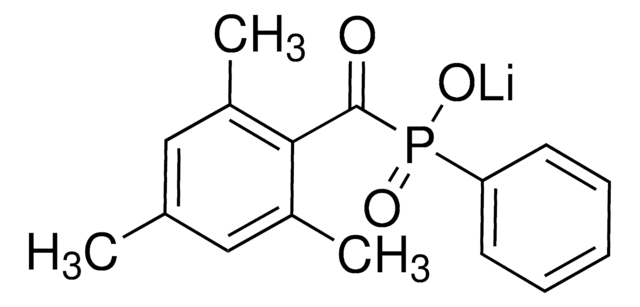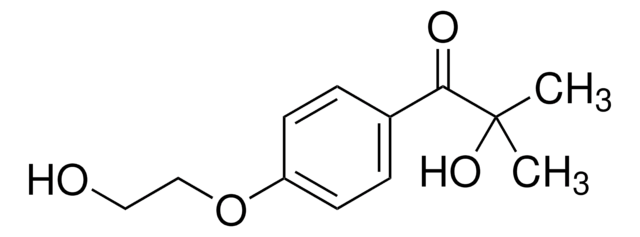Alle Fotos(1)
Wichtige Dokumente
915858
Poly(ethylene glycol)-block-poly(propylene glycol)-block-poly(ethylene glycol) diacrylate
average Mn ~5,800
Synonym(e):
PEG-PPG-PEG, Pluronic P-123 diacrylate, Pluronic diacrylate
Anmeldenzur Ansicht organisationsspezifischer und vertraglich vereinbarter Preise
Alle Fotos(1)
About This Item
Lineare Formel:
C3H3O[C2H4O]x[C3H6O]y[C2H4O]zC3H3O2
UNSPSC-Code:
51171641
NACRES:
NA.23
Empfohlene Produkte
Suchen Sie nach ähnlichen Produkten? Aufrufen Leitfaden zum Produktvergleich
Verwandte Kategorien
Anwendung
Poloxamers are nonionic, triblock copolymers containg a central hydrophobic chain of poly(propylene glycol) (PPG) and two terminal hydrophilic chains of poly(ethylene glycol) (PEG). Due to their amphiphilic structure, poloxamer solutions feature temperature dependent self-assembling and thermo-gelling behavior. Concentrated aqueous solutions of poloxamers are liquid at low temperature and form a gel at higher temperature, in a reversible process. This characteristic has allowed for these materials to be used as drug carriers for most routes of administration including oral, topical, intranasal, ocular, and parenteral. Acrylate-modified derivatives are most commonly used as thermosensitive hydrogels for drug delivery and 3D bioprinting applications. After casting or printing, the material can be crosslinked to preserve the hydrogel structure.
Lagerklassenschlüssel
11 - Combustible Solids
WGK
WGK 3
Flammpunkt (°F)
Not applicable
Flammpunkt (°C)
Not applicable
Hier finden Sie alle aktuellen Versionen:
Analysenzertifikate (COA)
Lot/Batch Number
Die passende Version wird nicht angezeigt?
Wenn Sie eine bestimmte Version benötigen, können Sie anhand der Lot- oder Chargennummer nach einem spezifischen Zertifikat suchen.
Besitzen Sie dieses Produkt bereits?
In der Dokumentenbibliothek finden Sie die Dokumentation zu den Produkten, die Sie kürzlich erworben haben.
Smart hydrogels for 3D bioprinting
Shuai W, et al.
International Journal of Bioprinting, 1(1), 3-14 (2015)
Self-Assembly of Pluronic F127 Diacrylate in Ethylammonium Nitrate: Structure, Rheology, and Ionic Conductivity before and after Photo-Cross-Linking
Carlos R L, et al.
Macromolecules, 49(14), 5179-5189 (2016)
Photopolymerization of Pluronic F127 diacrylate: a colloid-templated polymerization
Manuela D B, et al.
Soft Materials, 7, 4928-4937 (2011)
J J Escobar-Chávez et al.
Journal of pharmacy & pharmaceutical sciences : a publication of the Canadian Society for Pharmaceutical Sciences, Societe canadienne des sciences pharmaceutiques, 9(3), 339-358 (2007-01-09)
It is, sometimes, desirable to maintain a constant plasma drug concentration within the therapeutically effective concentration range. The use of high viscosity hydromiscible vehicles such as hydrophilic gels, is one of various approaches for controlled drug delivery, and represents an
Christopher J Hansen et al.
Advanced materials (Deerfield Beach, Fla.), 25(1), 96-102 (2012-10-31)
Microvascular multinozzle arrays are designed and fabricated for high-throughput printing of functional materials. Ink-flow uniformity within these multigeneration, bifurcating microchannel arrays is characterized by computer modeling and microscopic particle image velocimetry (micro-PIV) measurements. Both single and dual multinozzle printheads are
Unser Team von Wissenschaftlern verfügt über Erfahrung in allen Forschungsbereichen einschließlich Life Science, Materialwissenschaften, chemischer Synthese, Chromatographie, Analytik und vielen mehr..
Setzen Sie sich mit dem technischen Dienst in Verbindung.




